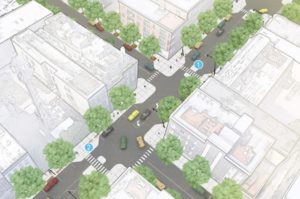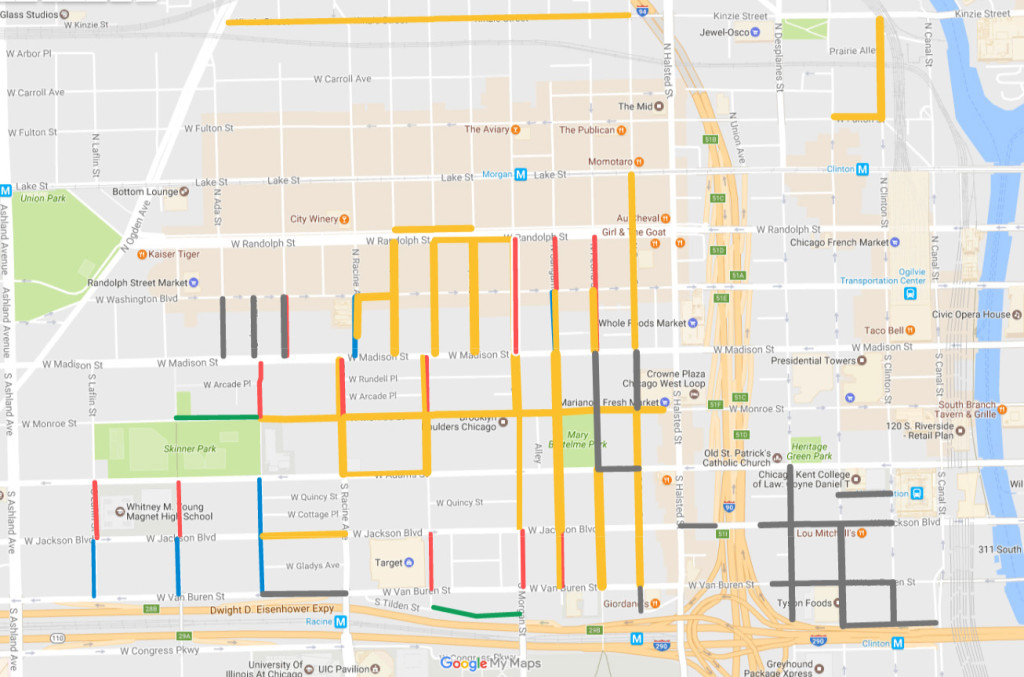Traffic
As the resident and employee population of the neighborhood continues to grow, the demand on the transportation network has increased considerably. Travel times within and across the West Loop have been adversely impacted by construction zones, more frequent deliveries, and simply more vehicles. These factors have also exposed transportation challenges that were previously known to those that lived nearby, e.g., poor sightlines on Lake Street, capacity issues on the #20 Madison bus line, limited roadway width on Racine Street north of Lake Street, pedestrian crossing safety issues on Randolph and Madison Street. The following are recommendations to address some of these issues:
2.1 A neighborhood-wide traffic study is needed to highlight problem areas and recommend capacity, traffic control, and traffic signal timing improvements. Ideally this would include a traffic model for the area that could be updated as new development projects are proposed so their true macroscopic impact can be determined, as opposed to localized traffic studies that do not consider cumulative effects.
2.2 Improvements to the safety of pedestrian facilities should be provided near parks, schools freeway access points, and along routes that see high vehicular and foot traffic, especially Madison, Washington, Randolph, Lake, and Ogden Streets. This should include measures that promote pedestrian and cyclist safety, such as corner bump-outs on Madison and the replacement of service drives along Randolph with pedestrian- and bike-friendly infrastructure as proposed in the West Loop Design Guidelines (so long as concerns about parking and business access are addressed).
2.3 As proposed in WCA’s parking and land use plan, residents support the idea of a Metra stop near Ashland Avenue and want shuttle buses to operate between Union and Ogilvie stations to support the increasing number of commuters headed to West Loop employment centers like Google and McDonald’s.
2.4 The following transit improvement recommendations are intended to manage commuters headed from the West Loop to the central business district:
- Increased CTA bus and train service on the #20 Madison and #126 Jackson lines
- Reintroduction of the X20 express bus on Washington.
- A new north-south bus route within the West Loop that provides a connection to the Morgan L station.
- Extension of the Morgan L stop platforms
- All bus stops should have shelters where space is available (new development projects should account for this concept)
2.5 One or more contiguous bike lanes be installed to/from the West Loop to those on Washington (inbound) and Randolph (outbound) are recommended. Lake Street is not a desired bike lane route.
Parking
Once abundant, parking capacity across the West Loop has become scarce, especially in residential areas. As detailed in WCA’s plan, this is predominantly due to the manner in which parking is controlled. Most street parking in the area is free, with a limited number of permit and “buffer” spaces that are only available to nearby residents and their guests. As previously described, the City is about to implement a resident parking permit program along a handful of north-south, mostly residential streets. The permits would be required between the hours of 7 and 9 am, which would limit parking options for suburban commuters, or “daytrippers”, that park in the West Loop and use transit to complete their commute further downtown. With this program in mind, the community offers the following resident-driven recommendations:
3.1 Expand the resident permit parking program geographically, initially to those routes highlighted in gold in Figure 14 and then to remaining West Loop residential streets that currently have free parking.
3.2 The program should include the ability for residents to obtain temporary guest parking permits.
3.3 Wherever the program is applied near businesses, the City should allow the businesses to obtain parking permits.
3.4 The City should diligently enforce the resident permit parking program and consider extending it to the hours of 4 to 6 pm (in addition to the proposed 7-9 am timeframe) to preserve parking capacity for residents on their evening commutes.
3.5 Loading zones should be provided for businesses that have frequent drop-offs/pick-ups, e.g., along Green Street north of Washington.
3.6 Private parking lots should be invited to offer shared parking, whereby commuters to the West Loop can pay to park during working hours and residents and West Loop visitors and valet services can reserve the parking spaces in the evenings, overnight, and on weekends.
3.7 Additional consideration should be made to provide parking for suburban commuters displaced by the West Loop resident permit parking program, e.g., United Center parking lots and business- or building-funded shuttles.
3.8 Developers of Transit Orient Developments (TOD) should sign an agreement similar to other neighborhoods where their residents will not be able to participate in permit parking (see recommendation 1.12). Residents from TOD developments may still purchase visitor permit parking stickers.


